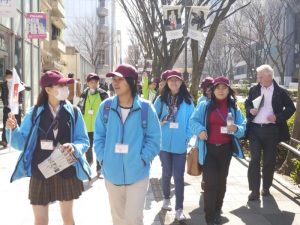Now in its fifth day, Toshiba Youth Club Asia is moving forward at full steam, carrying its 16 participants and advisors from event to event, and presenting them with enough food for thought for an intellectual feast.
After arriving in Japan on Monday, settling in, and in some cases struggling to get over the scale, density and intensity of Tokyo, the participants were given a day to get to know one another and to get an idea of the what the club was about to offer. On Day 2, it was down to business. The students were formed into teams—more about that below—and given the opportunity to talk about the challenges and problems their respective countries face—a chance to find out what they shared, and what is unique to each country.
The essence of the program is teams. The students are divided into groups of four (teams T, Y, C and A), and within their group they play one of four roles: politician, scientist, economist and sociologist. During the course of the program, each day has a theme, and in the evening, the team members write a journal reporting and commenting on what they learned during the day. The twist here is that the journals are written according to role; one by the politicians, one by the economist, and so on, and proposals are made from these different perspectives. On Sunday, the penultimate day, the teams will make a presentation to sum up what they have learned and share their ideas for the future, with each member contributing from the perspective of his or her role.
On Day 3, Wednesday, the program really got down busy, exploring the theme of Environment & Development. That was facilitated by a visit to Keio University Shonan Campus, to be introduced to the concepts of logy and nomy. If that sounds cryptic, think about ecology and economy, and the concepts expressed by both. Thursday was Technologies & Lifestyle Day, and the events included a visit to Toshiba Science Museum, a great place to visit if you are ever in Kawasaki, a ride on the Shinkansen, and a tour of Tokyo Station. Lunch was at the Ramen Museum, which sounds like a must-visit destination.
Today, Friday, Day 5, is Urbanization & Diversity Day, and as this was a time when the teams would be moving around and it was easier to talk to them, we went along to see what was happening and how the participants were enjoying the club.
The scene for the day was set in a lecture by Mr. Makoto Shirai, the President of Toshiba International Foundation. He explained how modern Tokyo, a city that looks as if it must have existed forever, is in fact a relatively new creation that has quickly spread out from a small nucleus. A photograph of Harajuku then and now underlined the contrast: today’s Harajuku is a sea of buildings surrounding the green island of Meiji Jingu and Yoyogi Park; the Harajuku of 100 years ago a place of rolling fields.
Mr. Shirai explained how, in building modern Harajuku, the people tried to maintain the spirit of old Japan; that behind the wide, tree-lined boulevard of Omote Sando was another Harajuku of narrow winding streets, and, of course, the timeless air of the Meiji shrine.
After this, it was off to explore. The first part of the day was, naturally enough, leather on pavement, a look at Harajuku’s streets. The groups set off with their advisors to take a walk down the hyper-fashionable Omote Sando and its international brand names, and then to peek into back streets to see small shops, ateliers, restaurants, houses and apartment blocks pressing closely against each other along narrow streets and alleys. All in all, it was a reminder that, however advanced a city is, it must also nurture a sense of community and belonging.
Following an all-you-can-eat lunch of okonomiyaki, usually described as Japanese pizza or soul food, the entire group set off to see Meiji Jingu and for a tour of the Kaguraden. This is a hall for sacred music and dance, and the TYCA participants were treated to a special performance of the Kigansai ceremony. After that, the afternoon’s events ended with a visit to the Kaigakan, the Meiji Picture Gallery, to see how artist’s in the Meiji period responded to Japan’s modernization, and the impact it had on their work.
So what do the participants think of it so far? For such a diverse group—this edition of TYCA has participants from seven countries—the response was surprisingly uniform: “Very interesting,” “Very informative,” “Really fun and interesting,” “Amazing, unbelievable,” “It’s so interesting because I can learn a lot of things about each country.” Different names and faces, but a similar smile and shared sentiments.
Perhaps this shouldn’t be too surprising. Spending time with the participants made it crystal clear that they are smart and engaged and like to be challenged intellectually. One of the advisors, who works in a college, said she came along because she was interested to see what the next generation of students was like. In her opinion, if these students are representative, it’s a pretty promising generation. Agreed!







